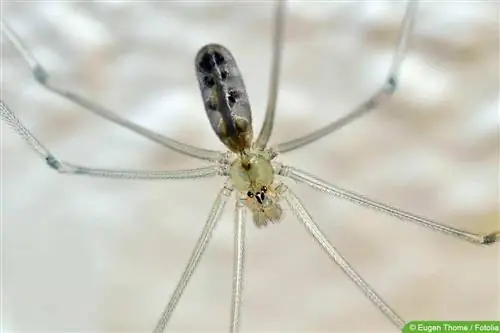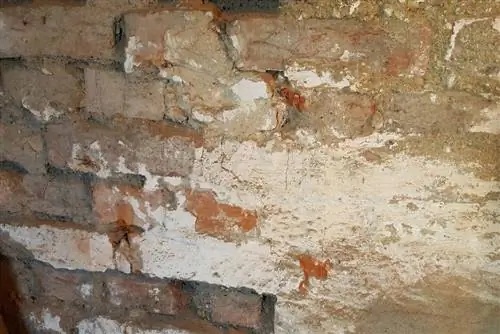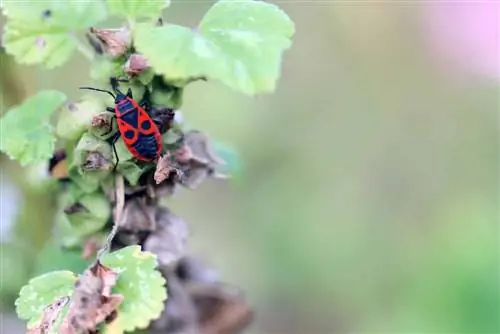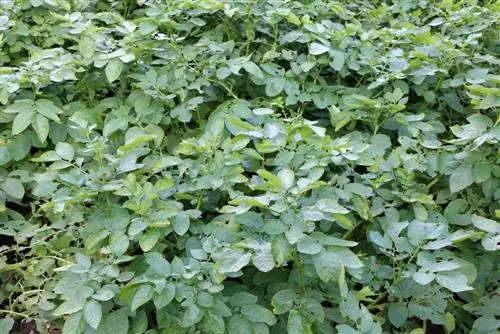- Author admin [email protected].
- Public 2023-12-17 03:39.
- Last modified 2025-01-24 12:45.
If pests settle in the garden pond, immediate intervention is required. The unwanted pests can spread quickly and become a real nuisance. Some of the pests only eat the pond plants, while others even attack the pond inhabitants. Since chemical pesticides also have a negative effect on the fish and plants in the garden pond, natural measures are recommended. In this way, the biological balance in the biotope is maintained.
Aphids
Water lilies in particular are attacked by pests, especially aphids. This pest prefers the soft tissue of pond plants that grow above the surface of the water. The natural enemies of the water lily aphids have proven to be effective antidotes; they keep the pest population at a tolerable level. In late summer, the aphids move to nearby trees to lay their eggs. It is therefore worth interrupting the reproductive cycle of the parasites on deciduous trees. In this way, the number of aphids can be significantly reduced.
- Aphids suck the juice out of water lilies
- This extremely weakens the pond plants
- If water lilies are infested, spray them regularly with a garden hose
- Ladybird larvae like to eat aphids
- Pond fish also feed on these pests
- Treat surrounding trees with pesticides in winter
caddisflies
In the adult stage, caddisflies are reminiscent of moths. These pests fly around the pond, especially in the early evening hours. Caddis flies lay hundreds of eggs in the water of the garden pond and can therefore quickly develop into a nuisance. After about ten days, the voracious larvae hatch from the eggs and can eat all the plants in the garden pond. Since chemical control is not possible due to the other pond inhabitants, the vermin's natural enemies should provide defense.
- Caddis flies lay their eggs in long and gelatinous tubes
- These mostly depend on the leaves of pond plants
- Collect egg tubes by hand
- Rely on natural predators such as goldfish and pond carp
Water lily borer
The water lily borer, a type of moth that is mainly active in the cooler evening hours, is widespread. The larvae of these moths like to eat holes in the leaves of pond plants, the result is very unsightly. Often entire leaves are eaten down to the skeleton, causing extreme damage to the plants.
- Water lily borer is about 2-3 cm tall
- Identified by irregular, white spots on the wings
- Pupas hibernate in fallen leaves
- Immediately remove these leaves from the pond surface
- In the fall, stretch an additional protective net over the garden pond
Cicadas
Just like aphids, cicadas also like to feed on water lily leaves. Large water lily leaves that are completely in the air are particularly susceptible to feeding damage. That's why the water lilies should never get too big so that the leaves have enough space to grow and can rest completely on the surface of the water. Overgrowing the garden pond with water lilies is not recommended anyway, as this will disrupt the biological balance in the biotope.
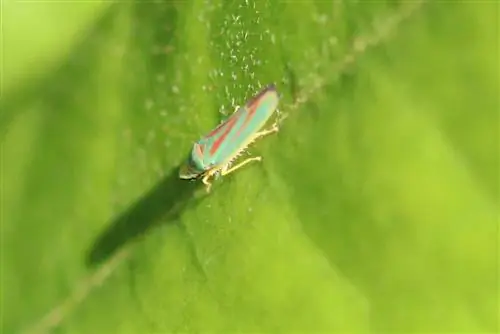
- Sucking the juice from the leaves of water lilies
- These then turn brown and appear dried out
- Separate water lilies that have grown too large and divide roots
- Then plant again with enough space available
Backstrokers
The backswimmer is a species of water beetle that has a particularly bad reputation among pond owners. Although the beetle is tiny, it can even kill small pond fish. The backswimmers fly around a lot between different ponds in the area, making them difficult to control. If a lot of small fish die at once, then this is an indication of an infestation with the aggressive water beetle.
- Has poisonous mouthparts
- Can kill small fish by biting them
- Watch out for water beetle flight traffic on summer evenings
- Put a small-mesh net over the garden pond as protection
Water lily leaf beetle
The water lily leaf beetle is a colorful water beetle, but this pest is not welcome in home water gardens. The beetle lives on the tops of the leaves of pond plants. Once under water, it can no longer swim to the surface of the pond on its own and subsequently drowns. That's why the lower sides of the leaves are spared so that they don't perish.
- If the infestation is small, spray the leaves with a strong jet of water
- Offspring create feeding passages on the upper sides of the leaves
- Press affected leaves under water, then secure them there with wire
- Pests are transported into the water and drown
- If the infestation is severe, cut off the affected leaves completely and dispose of them
Water Scorpion
The water scorpion is not related to the scorpions, but it is just as unpleasant. In the event of an infestation, you need to act quickly, otherwise the pest can be very dangerous, especially for young fish.
- Can kill small fish
- Recognizable by snorkel-like breathing opening
- Has a spine-like spine
- If you see the breathing opening on the water surface, remove parasites
- Keep your garden pond very clean as a preventive measure
Preventive measures
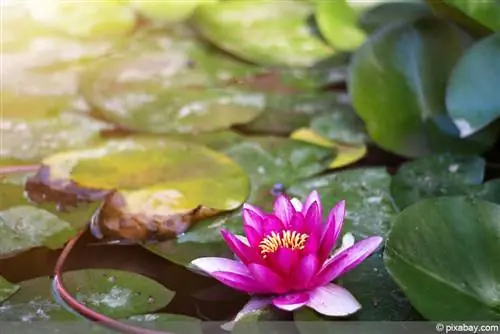
Vermin also have a right to exist in the garden pond ecosystem, but they can quickly become a nuisance. In addition, beneficial insects can become pests if they occur in large numbers. Normally, a well-functioning biotope manages to independently maintain its own biological balance over the long term. Even if a population of pests becomes overwhelming in the short term, natural predators are present. However, with newly created garden ponds it can take a few years until a good balance is achieved for all residents. That's why new water gardens in particular should be checked and maintained regularly. Water lilies in particular spread quickly and attract many pests.
- Ensure absolute cleanliness in the garden pond
- Don't give the pond fish too much food in summer
- Uneaten fish food sinks to the bottom
- Afterwards there will be contamination
- Use mud cleaner for extremely cloudy water
- Suck out about two thirds of the sludge
- Clean pond filter regularly
- Cut back very overgrown pond plants
- Immediately remove dead plant parts and leaves
- Skim off excessive algae growth with a landing net
- Collect beetle larvae and caterpillars by hand


